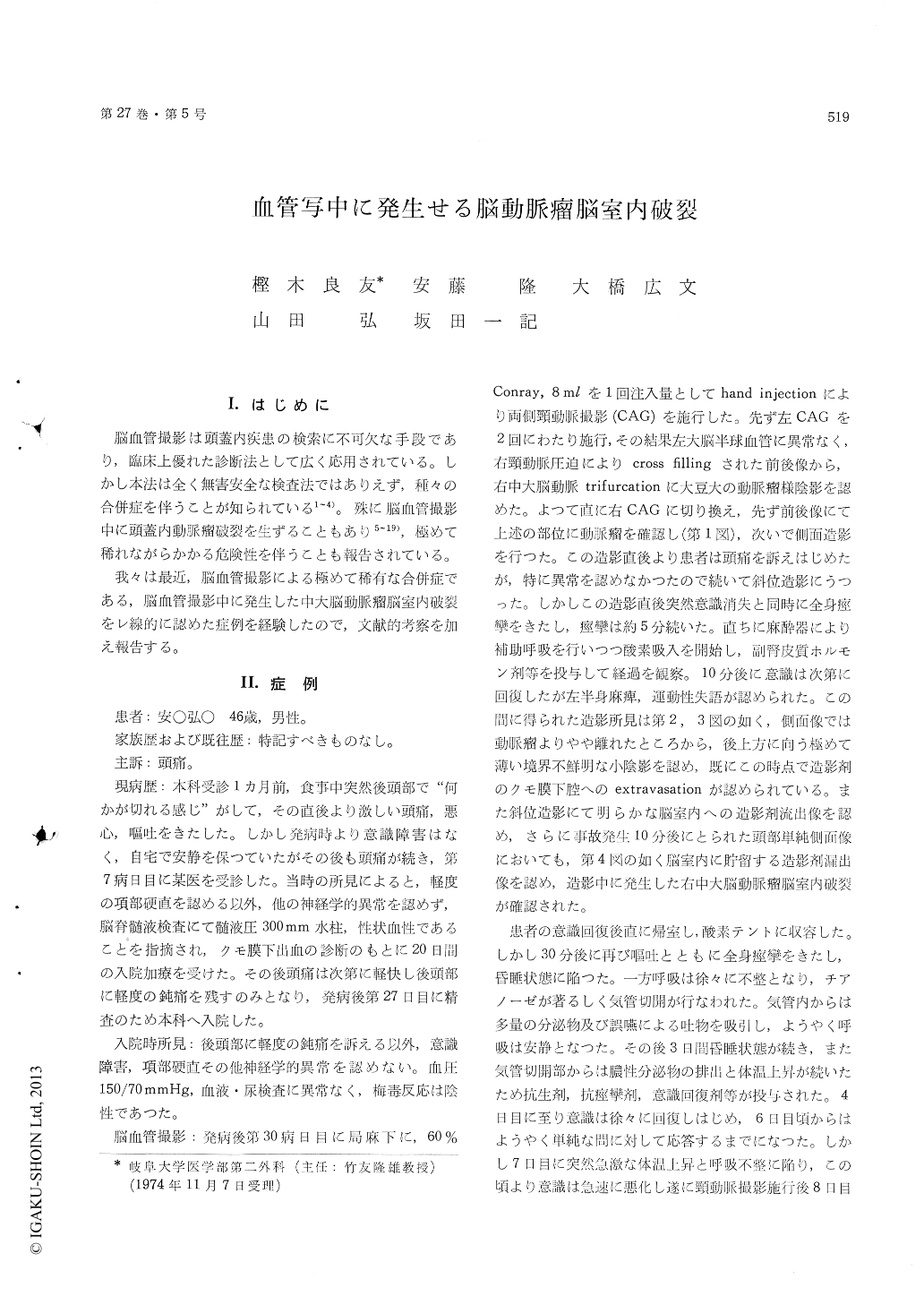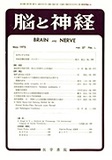Japanese
English
- 有料閲覧
- Abstract 文献概要
- 1ページ目 Look Inside
I.はじめに
脳血管撮影は頭蓋内疾患の検索に不可欠な手段であり,臨床上優れた診断法として広く応用されている。しかし本法は全く無害安全な検査法ではありえず,種々の合併症を伴うことが知られている1〜4)。殊に脳血管撮影中に頭蓋内動脈瘤破裂を生ずることもあり5〜19),極めて稀れながらかかる危険性を伴うことも報告されている。
我々は最近,脳血管撮影による極めて稀有な合併症である,脳血管撮影中に発生した中大脳動脈瘤脳室内破裂をレ線的に認めた症例を経験したので,文献的考察を加え報告する。
A fatal case of intracranial rupture of a rightmiddle cerebral artery aneurysm during cerebralangiography was reported.
A 46-year-old man suffered from sudden severeheadache, nausea and vomiting 27 days befor hisadmission to our department. He took rest in bedat his home for 1 week. Then he consulted adoctor because of contineuous headache. The doctorpointed out that he had mild nuchal rigidity andthat his CSF was bloody and was 300 mmH2O inpressure. After having been treated by the doctorfor 20 days he was admitted to our department.
On admission no neurological abnormality wasfound although he complained of dull occipitalheadache (i. e. Grad I of Hunt and Hess); His bloodpressure was 150 (Max.) and 70 (min.) mmHg.Findings of routine serum and urine examinationswere normal.
Thirty days after the attack of subarachnoidhemorrhage, serial carotid angiographies were doneon both sides (2 injections on the left side and 3injections on the right side) under local anesthesia.Eight ml of 60% Conray were injected each time.
Immediately after the 5 th (right carotid) injection,aming at obtaining an oblique view, the patientshowed a generalized convulsion falling into coma.On angiogram at this time intraventricular ruptureof an aneurysm of the right middle cerebral arterywas corroborated radiographically; the angiogramshowed extravasation of contrast material into thelateral ventricle. This was still present in a lateralplain skull film obtained about ten minutes later.His consciousness became gradually clear, althoughright hemiplegia and motor aphasia were remaining.In 30 minutes, however, he again into coma withrecurrent generalized convulsions and remained un-responsive for 4 days. Thereafter he recoveredconsciousness again, but on the 7 th day after theaccident he showed hyperthermia, fell into coma,and died on the 8 th day.
According to our survey of the literature, ven-tricular opercification due to rupture of an aneurysmduring cerebral angiography has been reported nomore than 5 times. All of the reported case diedafter such an accident.
In general it has been said that rupture of ananeurysm during cerebral angiography is rare, andespecially, aneurysmal rupture into the ventricularsystem during cerebral angiography is a quite rareoccurrence. However in the reports on subarachnoidhemmorrhage studied postmortem, It has beensuggested that rupture of an aneurysm into theventricular system is not rare. It has been statedin these reports that prognosis in such cases arefar poorer than that in cases of aneurysmal ruptureinto the subarachnoid space.
An exact mechanism of rupture of an intracranialaneurysm during cerebral angiography is stillobscure, although possible causative factors havebeen described by various authors. Since it is atleast certin that there do exist rare cases of an-eurysmal rupture during angiography, cerebralangiography in cases of subarachnoid hemorrhageshould be performed with caution.

Copyright © 1975, Igaku-Shoin Ltd. All rights reserved.


